Bacterial exposure induces and activates matrilysin in mucosal epithelial cells
- PMID: 10725342
- PMCID: PMC2174301
- DOI: 10.1083/jcb.148.6.1305
Bacterial exposure induces and activates matrilysin in mucosal epithelial cells
Abstract
Matrilysin, a matrix metalloproteinase, is expressed and secreted lumenally by intact mucosal and glandular epithelia throughout the body, suggesting that its regulation and function are shared among tissues. Because matrilysin is produced in Paneth cells of the murine small intestine, where it participates in innate host defense by activation of prodefensins, we speculated that its expression would be influenced by bacterial exposure. Indeed, acute infection (10-90 min) of human colon, bladder, and lung carcinoma cells, primary human tracheal epithelial cells, and human tracheal explants with type 1-piliated Escherichia coli mediated a marked (25-50-fold) and sustained (>24 h) induction of matrilysin production. In addition, bacterial infection resulted in activation of the zymogen form of the enzyme, which was selectively released at the apical surface. Induction of matrilysin was mediated by a soluble, non-LPS bacterial factor and correlated with the release of defensin-like bacteriocidal activity. Bacteria did not induce matrilysin in other cell types, and expression of other metalloproteinases by epithelial cells was not affected by bacteria. Matrilysin was not detected in germ-free mice, but the enzyme was induced after colonization with Bacteroides thetaiotaomicron. These findings indicate that bacterial exposure is a potent and physiologically relevant signal regulating matrilysin expression in epithelial cells.
Figures









Similar articles
-
Matrilysin expression and function in airway epithelium.J Clin Invest. 1998 Oct 1;102(7):1321-31. doi: 10.1172/JCI1516. J Clin Invest. 1998. PMID: 9769324 Free PMC article.
-
Polyamine-dependent expression of the matrix metalloproteinase matrilysin in a human colon cancer-derived cell line.Mol Carcinog. 1994 Nov;11(3):138-44. doi: 10.1002/mc.2940110304. Mol Carcinog. 1994. PMID: 7945802
-
Matrilysin expression by human mononuclear phagocytes and its regulation by cytokines and hormones.J Immunol. 1995 Jun 15;154(12):6484-91. J Immunol. 1995. PMID: 7759883
-
Matrix-degrading metalloproteinases in tumor progression.Princess Takamatsu Symp. 1994;24:152-61. Princess Takamatsu Symp. 1994. PMID: 8983072 Review.
-
Matrilysin in early stage intestinal tumorigenesis.APMIS. 1999 Jan;107(1):102-10. doi: 10.1111/j.1699-0463.1999.tb01532.x. APMIS. 1999. PMID: 10190286 Review.
Cited by
-
The Role of Membrane-Type 1 Matrix Metalloproteinase-Substrate Interactions in Pathogenesis.Int J Mol Sci. 2023 Jan 22;24(3):2183. doi: 10.3390/ijms24032183. Int J Mol Sci. 2023. PMID: 36768503 Free PMC article. Review.
-
Pathogenesis of Neisseria gonorrhoeae and the Host Defense in Ascending Infections of Human Fallopian Tube.Front Immunol. 2018 Nov 21;9:2710. doi: 10.3389/fimmu.2018.02710. eCollection 2018. Front Immunol. 2018. PMID: 30524442 Free PMC article. Review.
-
The Role of Gut Microbiota and Environmental Factors in Type 1 Diabetes Pathogenesis.Front Endocrinol (Lausanne). 2020 Feb 26;11:78. doi: 10.3389/fendo.2020.00078. eCollection 2020. Front Endocrinol (Lausanne). 2020. PMID: 32174888 Free PMC article. Review.
-
Syndecan-1 is an in vivo suppressor of Gram-positive toxic shock.J Biol Chem. 2008 Jul 18;283(29):19895-903. doi: 10.1074/jbc.M801614200. Epub 2008 May 22. J Biol Chem. 2008. PMID: 18499671 Free PMC article.
-
Shedding of Syndecan-1/CXCL1 Complexes by Matrix Metalloproteinase 7 Functions as an Epithelial Checkpoint of Neutrophil Activation.Am J Respir Cell Mol Biol. 2016 Aug;55(2):243-51. doi: 10.1165/rcmb.2015-0193OC. Am J Respir Cell Mol Biol. 2016. PMID: 26934670 Free PMC article.
References
-
- Birkedal-Hansen H. Role of matrix metalloproteinases in human periodontal diseases. J. Periodontol. 1993;64:474–484. - PubMed
-
- Birkedal-Hansen H., Moore W.G.I., Bodden M.K., Windsor L.J., Birkedal-Hansen B., DeCarlo A., Engler J.A. Matrix metalloproteinasesa review. Crit. Rev. Oral Biol. Med. 1993;4:197–250. - PubMed
Publication types
MeSH terms
Substances
Grants and funding
LinkOut - more resources
Full Text Sources
Other Literature Sources

